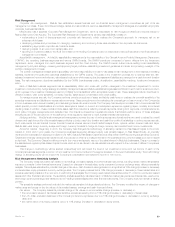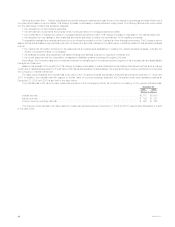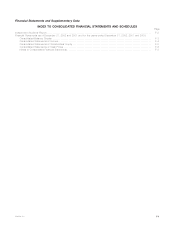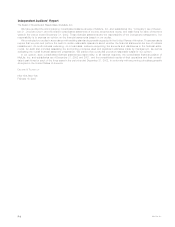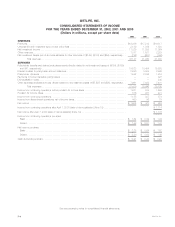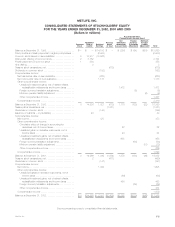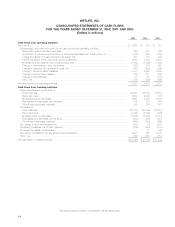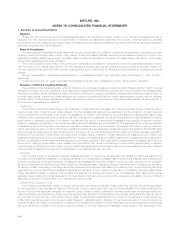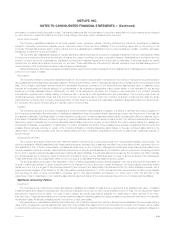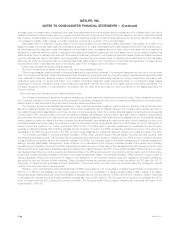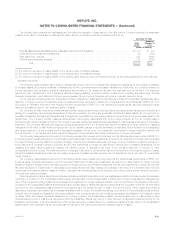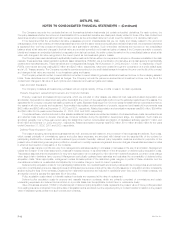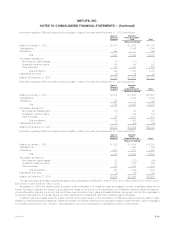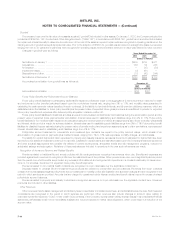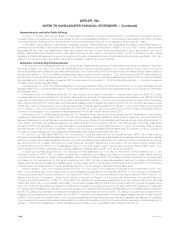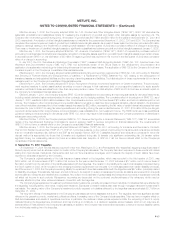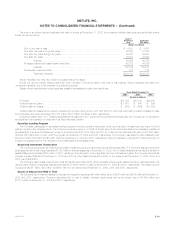MetLife 2002 Annual Report Download - page 53
Download and view the complete annual report
Please find page 53 of the 2002 MetLife annual report below. You can navigate through the pages in the report by either clicking on the pages listed below, or by using the keyword search tool below to find specific information within the annual report.METLIFE, INC.
NOTES TO CONSOLIDATED FINANCIAL STATEMENTS — (Continued)
amortization of deferred policy acquisition costs. This practice assumes that the expectation for long-term appreciation in equity markets is not changed
by minor short-term market fluctuations, but that it does change when large interim deviations have occurred.
Future Policy Benefits
The Company establishes liabilities for amounts payable under insurance policies, including traditional life insurance, annuities and disability
insurance. Generally, amounts are payable over an extended period of time and the profitability of the products is dependent on the pricing of the
products. Principal assumptions used in pricing policies and in the establishment of liabilities for future policy benefits are mortality, morbidity, expenses,
persistency, investment returns and inflation.
The Company also establishes liabilities for unpaid claims and claims expenses for property and casualty insurance. Pricing of this insurance takes
into account the expected frequency and severity of losses, the costs of providing coverage, competitive factors, characteristics of the insured and the
property covered, and profit considerations. Liabilities for property and casualty insurance are dependent on estimates of amounts payable for claims
reported but not settled and claims incurred but not reported. These estimates are influenced by historical experience and actuarial assumptions of
current developments, anticipated trends and risk management strategies.
Differences between the actual experience and assumptions used in pricing these policies and in the establishment of liabilities result in variances in
profit and could result in losses.
Reinsurance
The Company enters into reinsurance transactions as both a provider and a purchaser of reinsurance. Accounting for reinsurance requires extensive
use of assumptions and estimates, particularly related to the future performance of the underlying business and the potential impact of counterparty credit
risks. The Company periodically reviews actual and anticipated experience compared to the aforementioned assumptions used to establish policy
benefits and evaluates the financial strength of counterparties to its reinsurance agreements using criteria similar to that evaluated in the security
impairment process discussed above. Additionally, for each of its reinsurance contracts, the Company must determine if the contract provides
indemnification against loss or liability relating to insurance risk, in accordance with applicable accounting standards. The Company must review all
contractual features, particularly those that may limit the amount of insurance risk to which the Company is subject or features that delay the timely
reimbursement of claims. If the Company determines that a contract does not expose it to a reasonable possibility of a significant loss from insurance risk,
the Company records the contract using the deposit method of accounting.
Litigation
The Company is a party to a number of legal actions. Given the inherent unpredictability of litigation, it is difficult to estimate the impact of litigation on
the Company’s consolidated financial position. Liabilities are established when it is probable that a loss has been incurred and the amount of the loss can
be reasonably estimated. Liabilities related to certain lawsuits, including the Company’s asbestos-related liability, are especially difficult to estimate due to
the limitation of available data and uncertainty regarding numerous variables used to determine amounts recorded. The data and variables that impact the
assumption used to estimate the Company’s asbestos-related liability include the number of future claims, the cost to resolve claims, the disease mix
and severity of disease, the jurisdiction of claims filed, tort reform efforts and the impact of any possible future adverse verdicts and their amounts. It is
possible that an adverse outcome in certain of the Company’s litigation, including asbestos-related cases, or the use of different assumptions in the
determination of amounts recorded could have a material effect upon the Company’s consolidated net income or cash flows in particular quarterly or
annual periods.
Employee Benefit Plans
The Company sponsors pension and other retirement plans in various forms covering employees who meet specified eligibility requirements. The
reported expense and liability associated with these plans requires an extensive use of assumptions which include the discount rate, expected return on
plan assets and rate of future compensation increases as determined by the Company. Management determines these assumptions based upon
currently available market and industry data, historical performance of the plan and its assets, and consultation with an independent consulting actuarial
firm to aid it in selecting appropriate assumptions and valuing its related liabilities. The actuarial assumptions used by the Company may differ materially
from actual results due to changing market and economic conditions, higher or lower withdrawal rates or longer or shorter life spans of the participants.
These differences may have a significant effect on the Company’s consolidated financial statements and liquidity.
The actuarial assumptions used in the calculation of the Company’s aggregate projected benefit obligation may vary and include an expectation of
long-term market appreciation in equity markets which is not changed by minor short-term market fluctuations, but does change when large interim
deviations occur. For the largest of the plans sponsored by the Company (the Metropolitan Life Retirement Plan for United States Employees, with a
projected benefit obligation of $4.3 billion or 98.6% of all qualified plans at December 31, 2002), the discount rate, expected rate of return on plan assets,
and the range of rates of future compensation increases used in that plan’s valuation at December 31, 2002 were 6.75%, 9% and 4% to 8%,
respectively. Note 6 describes in more detail the assumptions used and status of the many plans sponsored by the Company and its affiliates.
Significant Accounting Policies
Investments
The Company’s fixed maturity and equity securities are classified as available-for-sale and are reported at their estimated fair value. Unrealized
investment gains and losses on securities are recorded as a separate component of other comprehensive income or loss, net of policyholder related
amounts and deferred income taxes. The cost of fixed maturity and equity securities is adjusted for impairments in value deemed to be other-
than-temporary. These adjustments are recorded as investment losses. Investment gains and losses on sales of securities are determined on a specific
identification basis. All security transactions are recorded on a trade date basis.
Mortgage loans on real estate are stated at amortized cost, net of valuation allowances. Valuation allowances are established for the excess carrying
value of the mortgage loan over its estimated fair value when it is probable that, based upon current information and events, the Company will be unable
to collect all amounts due under the contractual terms of the loan agreement. Valuation allowances are included in net investment gains and losses and
MetLife, Inc. F-9


